Do you know the different folk dances in the Philippines? From graceful movements to energetic performances,
these traditional dances hold a significant place in the country’s cultural heritage. They tell stories, celebrate
festivities, and showcase the unique traditions of each region. Join us on a journey to explore the vibrant world of
Philippine folk dances and uncover the rich tapestry of Filipino culture.
Key Takeaways:
- Philippine folk dances are a vibrant part of the country’s cultural heritage.
- These dances reflect the rich history and traditions of different regions in the Philippines.
- Popular folk dances include Tinikling, Cariñosa, Pandanggo sa Ilaw, and Maglalatik.
- These dances play a significant role in preserving the cultural identity of the Philippines.
- Exploring Philippine folk dances provides insights into the creativity, resilience, and unity of the Filipino people.
The Importance of Philippine Folk Dance
Philippine traditional dances, also known as cultural dance in the Philippines or Filipino folk dances, hold significant importance in preserving the country’s cultural identity. These dances serve as a form of artistic expression that showcases the history, traditions, and values of the Filipino people.
Through the graceful movements, intricate footwork, and vibrant costumes, these dances tell stories that have been passed down through generations, reflecting the rich tapestry of Philippine culture. They encompass a wide range of themes, from love and courtship to religious devotion and everyday life.
Moreover, Philippine folk dance plays a vital role in promoting unity and community engagement. These dances often bring people together during weddings, festivals, and other cultural gatherings, fostering a sense of pride in Filipino heritage and strengthening social bonds.
“Dancing is like dreaming with your feet.” – Constanze Mozart
It is through the practice and preservation of these traditional dances that the Filipino people connect with their roots, celebrate their diversity, and appreciate the unique contributions of each region in the Philippines. These dances serve as a powerful reminder of the nation’s past while embracing the present and inspiring future generations.
The Transformative Power of Cultural Dance
Engaging in cultural dance in the Philippines not only provides an avenue for artistic expression but also enables individuals to develop a deeper connection with their heritage. By participating in these dances, individuals gain a better understanding of their culture, values, and traditions.
Through the rhythm and movements of their bodies, dancers express emotions, tell stories, and convey messages. This form of self-expression becomes a source of empowerment, allowing individuals to celebrate their unique identities and showcase their talents.
Additionally, cultural dance in the Philippines offers various physical and mental health benefits. The energetic movements, coordination, and flexibility required in these dances improve physical fitness and motor skills. It also enhances memory, cognitive abilities, and overall well-being.
| Benefits of Philippine Folk Dance | Description |
|---|---|
| Preservation of Cultural Heritage | Folk dances help preserve and promote the rich cultural heritage of the Philippines. |
| Unity and Community Engagement | These dances bring communities together, fostering a sense of unity and pride in Filipino culture. |
| Artistic Expression | Through dance, individuals can artistically express emotions, stories, and messages. |
| Physical and Mental Health Benefits | Engaging in cultural dance improves physical fitness, motor skills, memory, and overall well-being. |
The Enduring Beauty of Philippine Folk Dance
As the Philippines continues to thrive and evolve, it is essential to recognize the enduring beauty and significance of Filipino folk dances. By preserving and promoting these dances, the country honors its rich history, traditions, and cultural diversity.
Through the enchanting movements of Philippine traditional dances, the world can catch a glimpse of the vibrant spirit and resilience of the Filipino people. These dances serve as a testament to the country’s artistic heritage and inspire generations to come.
The Origins of Philippine Folk Dance
The history of Philippine folk dance dates back to the time of indigenous tribes in the Philippines. Before the arrival of the Spanish colonizers, these diverse tribes had their own unique dances that were deeply rooted in their culture and traditions. These dances played a significant role in religious rituals, social gatherings, and community celebrations.
The indigenous dances of the Philippines were not only a means of entertainment but also a way to communicate with the spiritual realm and honor their ancestors. They were believed to bring blessings, fertility, and protection to the community. These dances were passed down through generations, keeping their cultural significance alive.
However, with the arrival of the Spanish colonizers in the 16th century, the dynamics of Philippine folk dance began to change. The Spaniards brought with them European influences and introduced their own styles of dance to the indigenous population. As a result, the traditional indigenous dances merged with Spanish elements, creating a fusion of cultures.
Spanish-influenced dances were eventually adapted to reflect the local customs and traditions of the Filipino people. This fusion gave rise to a new form of dance that showcased a harmonious blend of indigenous movements and European flair.
The Impact of Spanish Colonization on Philippine Folk Dance
During the Spanish colonization period, the Spanish authorities used dance as a means to spread Christianity and control the local population. The dances were fused with Christian themes and performed during religious festivals and processions. These dances became a way for the indigenous people to express their faith and devotion while incorporating their own cultural traditions.
“The evolution of Philippine folk dance is a testament to the resilience and adaptability of the Filipino people.”
The indigenous tribes embraced the Spanish-influenced dances and made them their own, infusing their own movements, music, and costumes. This adaptation allowed the Philippine folk dance to evolve and develop into a unique art form that exemplified the creativity and adaptability of the Filipino people.
Today, Philippine folk dance continues to be a vibrant and integral part of the country’s cultural heritage. It serves as a reminder of the rich history, traditions, and values that have shaped the Filipino identity. The dances have become a source of pride and a way to preserve and celebrate the diverse cultural heritage of the Philippines.
The Most Popular Folk Dances in the Philippines
When it comes to popular folk dances in the Philippines, there is no shortage of rhythmic and captivating performances that showcase the rich culture and traditions of the country. These dances have become an integral part of celebrations, festivals, and cultural gatherings, captivating audiences with their vibrant movements and storytelling.
Let’s take a closer look at some of the most well-known folk dances:
Tinikling
Tinikling is a dynamic and fast-paced dance that originated from the province of Leyte. It involves dancers skillfully maneuvering between bamboo poles, creating rhythmic and mesmerizing beats. As the dancers gracefully hop and weave through the moving poles, their timing and coordination are put to the test. Tinikling is a symbol of agility, teamwork, and a tribute to the nation’s abundance of bamboo resources.
Cariñosa
Known as the “Dance of Love,” Cariñosa is a romantic folk dance that elegantly portrays courtship and traditional Philippine movements. Dancers perform graceful gestures, flowing movements, and intricate footwork, often carrying fans or handkerchiefs as props. The dance beautifully captures the flirtatious charm and affectionate expressions of love.
Pandanggo sa Ilaw
Pandanggo sa Ilaw is an enchanting dance that originated from the province of Lubang. It showcases the dancer’s ability to balance and manipulate oil lamps, creating a mesmerizing display of light and movement. The graceful steps, combined with the rhythmic clapping of castanets, make Pandanggo sa Ilaw a captivating and visually stunning performance.
Maglalatik
Maglalatik is a male-only dance that originated in the province of Biñan, Laguna. It tells the story of a mock battle between Christians and Muslims over coconut meat, symbolized by the dancers’ use of coconut shells as props. Accompanied by lively music and energetic movements, the dancers skillfully maneuver the coconut shells, creating rhythmic beats that echo the cultural diversity and creativity of the Filipino people.
These are just a few examples of the popular folk dances that have become icons of Philippine culture. Each dance holds a unique significance and tells a story that is deeply rooted in the history and traditions of the Filipino people. Through their rhythmic movements, vibrant costumes, and cultural symbolism, these folk dances continue to captivate audiences and celebrate the rich heritage of the Philippines.
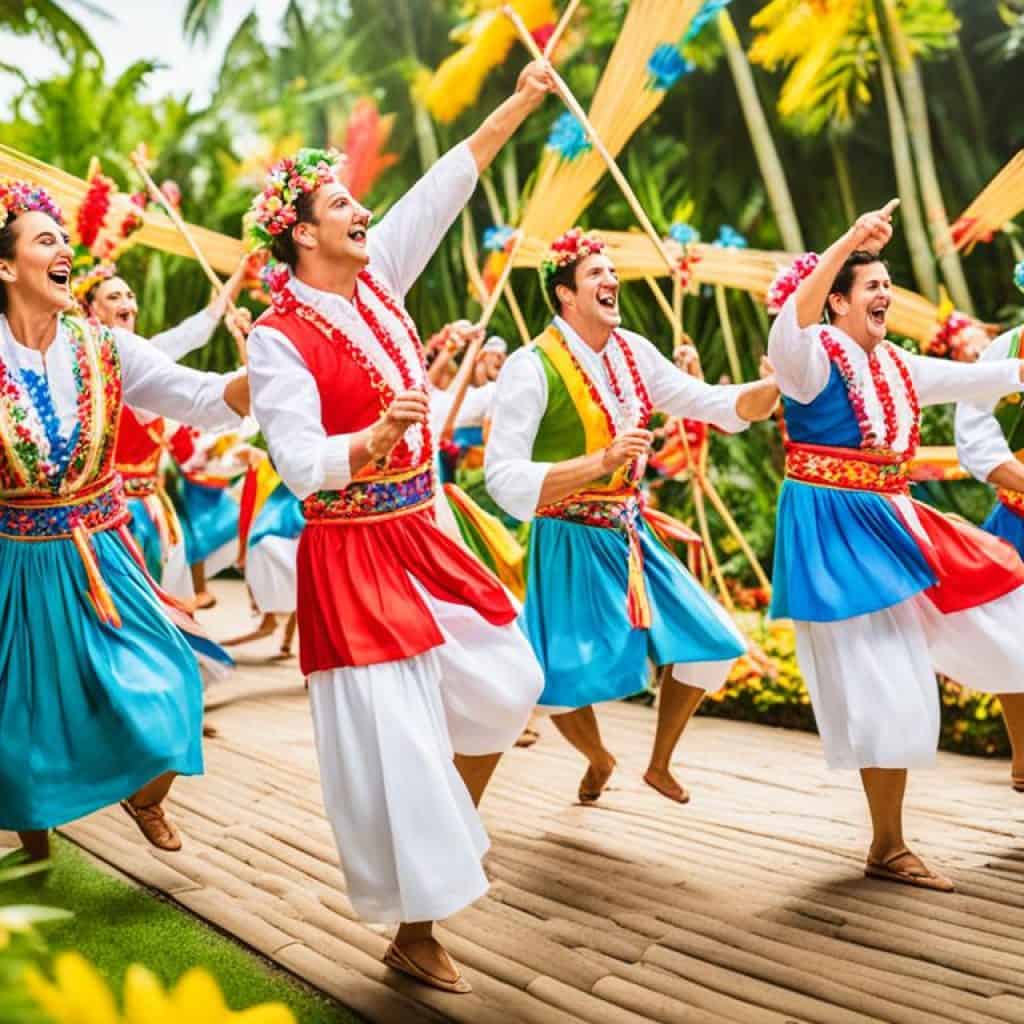
Tinikling – The National Dance of the Philippines
Tinikling is considered the national dance of the Philippines, representing the rich cultural heritage of the country. Originating from the Leyte province, this mesmerizing dance is inspired by the tikling bird, known for its graceful movements.
In the Tinikling dance, skilled dancers maneuver between parallel bamboo poles, creating a rhythmic pattern. The dancers’ feet swiftly and precisely avoid getting caught between the bamboo poles as they move with agility and grace. The precise timing and coordination required in the Tinikling reflect the dancer’s skill and discipline.
Tinikling showcases the Filipino people’s agility, resilience, and love for their cultural traditions. This iconic dance has become a symbol of Philippine culture and is often performed during festivals, weddings, and other cultural events.
Cariñosa – The Dance of Flirtation
Cariñosa is a popular folk dance in the Philippines that originated in Panay Island. It is known for its flirtatious movements and elegant choreography, captivating audiences with its graceful representation of courtship and affection.
In this dance, male and female dancers come together to showcase their admiration for one another using fans and handkerchiefs. The synchronized movements and subtle gestures express the romantic connection between the performers, creating a delightful and enchanting performance.
The name “Cariñosa” is derived from the Spanish word “cariño,” which translates to “affection” or “love.” It is a fitting name for a dance that embodies the tenderness and charm of Filipina women during the Spanish colonial period.
The dancers’ graceful steps and synchronized movements emphasize the elegance and sophistication of the dance. The performers move in sync with the rhythm of the music, gracefully gliding across the floor and rejoicing in the joy of courtship.
Throughout the dance, the use of fans and handkerchiefs adds a playful and flirtatious element, allowing the dancers to express their affection and admiration for one another. The fans and handkerchiefs become symbolic extensions of the dancers’ emotions, enhancing the overall beauty and allure of the performance.
Cariñosa is not only a captivating dance but also an important part of Philippine cultural heritage. It serves as a reminder of the country’s colonial history and showcases the grace, charm, and passion of the Filipino people.
Key Highlights:
- Cariñosa is a popular folk dance in the Philippines.
- Originating from Panay Island, it is known for its flirtatious movements and elegant choreography.
- In Cariñosa, male and female dancers express their affection for each other using fans and handkerchiefs.
- The use of fans and handkerchiefs adds a playful and flirtatious element to the dance.
- Cariñosa is a beautiful representation of the grace and allure of Filipina women during the Spanish colonial period.
Experience the charm and elegance of Cariñosa, a Philippine folk dance that beautifully captures the spirit of courtship and affection.
Pandanggo sa Ilaw – The Dance of Lights
Pandanggo sa Ilaw is a captivating dance that showcases the beauty and grace of Filipino culture. Originating from Lubang Island, Occidental Mindoro, this traditional dance is a celebration of light and is often performed during festivals and special events. The name “Pandanggo sa Ilaw” translates to “dance with light” in English, highlighting the central element of the performance.
In Pandanggo sa Ilaw, dancers skillfully balance oil lamps or glasses with lit candles on their heads and in their hands. The flickering flames create a mesmerizing interplay of light and shadow as the performers gracefully move across the stage. The dance is accompanied by the rhythmic sound of castanets, enhancing the overall visual and auditory spectacle.
The intricate footwork and fluid movements of Pandanggo sa Ilaw showcase the precision and skill of the dancers. The performers navigate the stage with elegance, carrying the delicate light sources with poise and agility. The dance embodies the harmony between the human body and the illuminating flames, symbolizing the unity between light and life.
“Pandanggo sa Ilaw is a beautiful manifestation of the Philippines’ rich cultural heritage. It serves as a testament to the creativity, grace, and artistry of the Filipino people.”
As a centerpiece of Filipino cultural dances, Pandanggo sa Ilaw reflects the values and traditions of the local communities. It is not only a visual spectacle but also an embodiment of the Filipino spirit and identity. The dance highlights the importance of light, both in a literal and metaphorical sense, symbolizing hope, joy, and enlightenment.
Pandanggo sa Ilaw has gained recognition not only within the Philippines but also internationally. Its captivating and enchanting performance has mesmerized audiences around the world, spreading awareness of the rich cultural heritage of the Filipino people.
Costume
The costume worn during Pandanggo sa Ilaw is an integral part of the dance. Dancers typically wear traditional Filipino attire, often in vibrant colors to reflect the festive nature of the dance. The costumes are adorned with intricate details and embellishments that add to the visual appeal of the performance.
Traditional Filipino Dances
| Dance | Origin | Description |
|---|---|---|
| Pandanggo sa Ilaw | Lubang Island, Occidental Mindoro | A dance that showcases the graceful movements of performers balancing oil lamps and glasses with lit candles on their heads and in their hands. |
| Tinikling | Leyte | A dance performed with bamboo poles, imitating the movements of tikling birds. |
| Cariñosa | Panay Island | A romantic dance that showcases the traditional Philippine movements and uses fans and handkerchiefs. |
| Maglalatik | Biñan, Laguna | A male-only dance performed with coconut shell halves, depicting either a mock battle between Christians and Muslims or a battle between different tribes. |
Pandanggo sa Ilaw is a testament to the cultural richness and diversity of the Philippines. Through its mesmerizing movements and illuminating lights, the dance captivates audiences and fosters a deeper appreciation for Filipino heritage. Experience the magic of Pandanggo sa Ilaw, a dance that brings light to the stage and unites hearts with its beauty.
Maglalatik – The Battle of Coconut Shells
Maglalatik is a captivating and energetic Philippine folk dance that showcases the resilience and creativity of the Filipino people. Originating in Biñan, Laguna, this unique dance involves male dancers wearing coconut shell halves on their bodies, creating a striking visual representation.
The roots of Maglalatik can be traced back to two different stories, both depicting battles. One story suggests that it symbolizes a mock battle between Christians and Muslims over coconut meat, which was a valuable food source. The other narrative portrays a fierce battle between different tribes, each fighting for supremacy.
Regardless of its origins, Maglalatik is a powerful performance that highlights the strength and agility of the dancers as they rhythmically clash the coconut shells, producing a captivating sound. The movements emulate combat, combining precise footwork, graceful arm gestures, and synchronized choreography.
Maglalatik represents more than just a dance; it is a celebration of Filipino culture and history. Through their arduous performance, the dancers honor their ancestors’ stories and demonstrate their unwavering spirit.
An image representing the captivating and energetic dance of Maglalatik.
Symbolism and Grace
Maglalatik embodies the resilience and unity of the Filipino people, showcasing their ability to transform everyday objects, like coconut shells, into powerful instruments of artistic expression. The dance illustrates the importance of preserving traditions and the unique cultural heritage of the Philippines.
The Battle Continues
The battle depicted in Maglalatik may have originated from historical conflicts, but today, it serves as a reminder of the strength and resilience of the Filipino people. This folk dance continues to captivate audiences and inspire future generations to honor their roots and celebrate their cultural identity.
Sayaw sa Bangko – Dancing on a Bench
Sayaw sa Bangko, also known as “dancing on a bench,” is a folk dance native to Pangasinan. This lively and captivating dance is performed on top of a narrow, six-inch-wide wooden bench, requiring dancers to showcase their impressive skill and impeccable balance. It is a visually stunning performance that highlights the agility, grace, and coordination of the dancers.
Sayaw sa Bangko is often performed during wedding feasts, serving as a symbolic representation of the newlyweds’ journey through life together. The dance signifies the challenges and obstacles that the couple may encounter, with the bench representing the path they must traverse side by side. By gracefully moving and maintaining balance on the narrow bench, the dancers convey the importance of trust, harmony, and synchrony in a successful partnership.
This vibrant and energetic folk dance is not only a testament to the rich cultural heritage of Pangasinan but also a celebration of the strength and unity of the Filipino people. Through their seamless movements and precise footwork, the dancers captivate audiences, leaving them in awe of the remarkable talent and artistry displayed in Sayaw sa Bangko.
The Beauty and Complexity of Sayaw sa Bangko
Sayaw sa Bangko is as complex as it is beautiful, with intricate choreography that requires synchronized movements from the dancers. The routine often involves intricate footwork, jumps, and turns, all performed with grace and precision on the narrow bench. The dancers must maintain perfect balance and coordination to execute the challenging steps flawlessly.
The music that accompanies Sayaw sa Bangko is lively and energetic, perfectly complementing the dynamic movements of the dancers. Traditional Philippine instruments such as the bandurria, guitar, and drums bring the dance to life, creating a rhythmic backdrop that adds excitement and energy to the performance.
| Key Features of Sayaw sa Bangko | Description |
|---|---|
| Performance Surface | A narrow, six-inch-wide wooden bench |
| Required Skills | Impeccable balance, agility, and coordination |
| Symbolism | Representation of the couple’s journey through life together |
| Emphasis | Trust, harmony, and synchrony in a successful partnership |
| Performance Occasions | Wedding feasts and cultural festivals |
Witnessing Sayaw sa Bangko is an unforgettable experience, as its unique and challenging nature demands the utmost skill and dedication from the dancers. This folk dance resonates with audiences, celebrating the beauty, strength, and resilience of Filipino culture and traditions. Sayaw sa Bangko is a testament to the power of art in conveying meaningful stories and preserving the rich heritage of Pangasinan.
Kuratsa – A Dance of Courtship
Kuratsa is a captivating folk dance from Samar Island, known for its portrayal of courtship through the rhythmic movements that imitate the mating dance of a rooster and a hen. This traditional dance is a celebration of love and the joyous pursuit of romantic connections.
The Kuratsa dance consists of three distinct parts:
- 1. Waltz: The dance begins with a waltz between a male and a female dancer, symbolizing the initial attraction and the beginning stages of courtship. The dancers gracefully move in synchronized patterns, conveying the elegance and charm of the courtship process.
- 2. Chase sequence: The second part of the Kuratsa dance is a playful chase sequence, where the male dancer pursues the female dancer in a lively and flirtatious manner. This segment emphasizes the excitement and anticipation that often accompanies the early stages of courtship.
- 3. Final reconciliation: The dance concludes with a final reconciliation, symbolizing the successful union of two souls in love. The dancers come together, showcasing their unity and the harmony they have achieved through courtship.
Kuratsa is characterized by its lively and energetic movements, accompanied by the traditional music and rhythms of the region. The intricate footwork, graceful gestures, and vibrant costumes add to the visual spectacle of this courtship folk dance.
Kuratsa reflects the playful and flirtatious nature of courtship in the Philippines, exemplifying the joyful pursuit of love and the traditions passed down through generations. It is an important cultural dance that preserves the customs and values associated with courtship, showcasing the rich heritage of Samar Island.
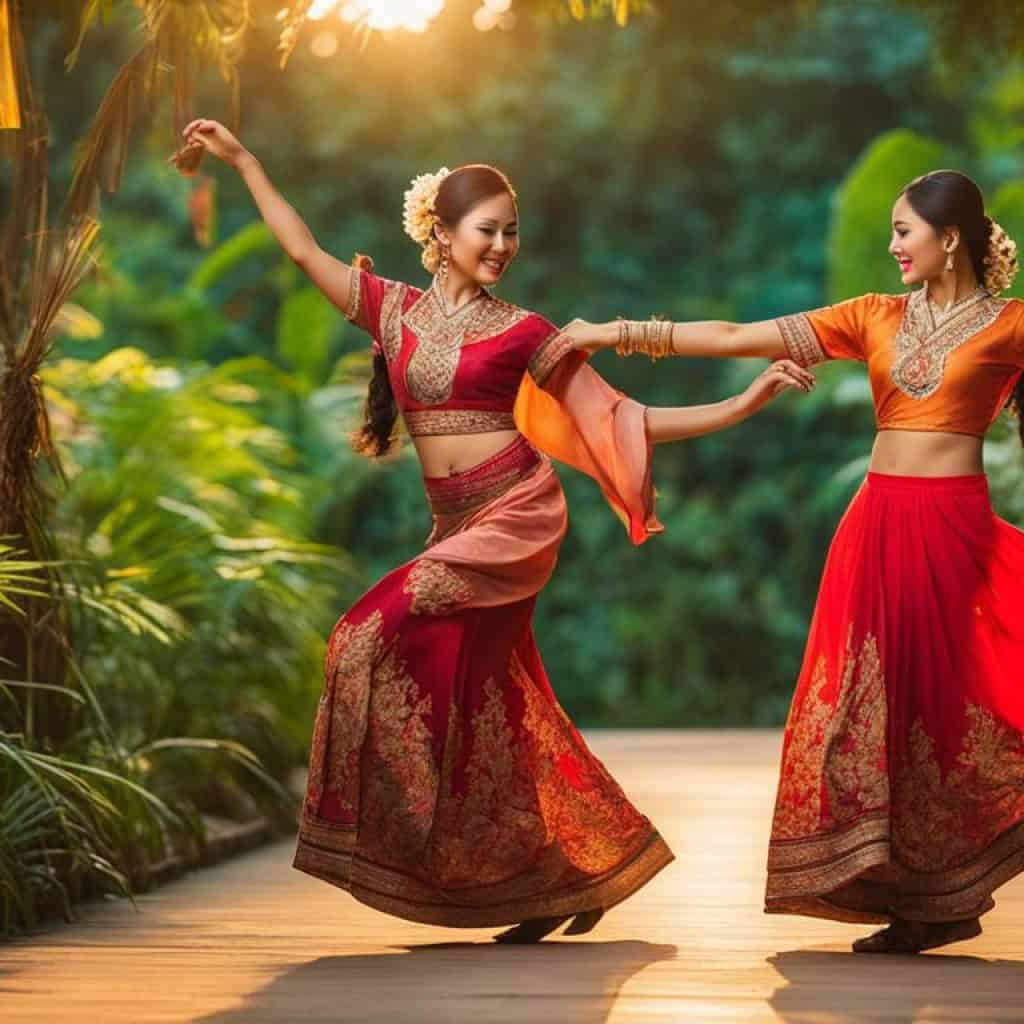
| Key Features | Description |
|---|---|
| Mimics Rooster and Hen Movements | Kuratsa imitates the mating dance of a rooster and a hen, symbolizing courtship. |
| Three Parts of the Dance | Kuratsa consists of a waltz, chase sequence, and final reconciliation. |
| Energetic and Lively Movements | The dance is characterized by lively movements that showcase the playful nature of courtship. |
| Preservation of Tradition | Kuratsa preserves the customs and values associated with courtship in Samar Island. |
Subli – A Religious Folk Dance
Subli is a religious folk dance originating from Bauan, Batangas, and holds great significance in the cultural traditions of the Filipino people. This mesmerizing dance is performed in honor of the Holy Cross of Alitagtag, showcasing the deep devotion and faith of the dancers.
Experienced male and female dancers come together to perform Subli, moving in a circular formation with intricate footwork. The dancers gracefully hop, slide, and sway, creating a visually captivating display. They hold brimmed hats and beat castanets, adding an element of rhythm and music to the dance.
Subli is a spiritual and enchanting performance that embodies the religious traditions of the region. It symbolizes the unity of the community and the unwavering devotion to their faith. Through this dance, the dancers express their gratitude and reverence towards the Holy Cross of Alitagtag.
| Key Features of Subli | Significance |
|---|---|
| The dancers hop, slide, and sway in a circular formation. | Symbolizes the unity and devotion of the community. |
| The dancers hold brimmed hats and beat castanets. | Expresses gratitude and reverence towards the Holy Cross of Alitagtag. |
| Experienced male and female dancers perform the dance. | Preserves and showcases the rich religious traditions of Batangas. |
Itik-Itik – The Dance of the Ducks
Itik-Itik is a folk dance from Surigao del Sur that showcases the playful and spirited nature of the Filipino people. This captivating dance imitates the movements of a duck, and its origins can be traced back to a legendary baptismal ceremony where a young woman entertained guests with her duck-like steps. Over time, the dance gained popularity and has been passed down through generations, becoming a cherished part of Surigao del Sur’s cultural heritage.
“Itik-Itik is a celebration of joy, creativity, and the vibrant spirit of the Filipino people.”
The Itik-Itik dance is characterized by lively footwork and flowing arm movements, mimicking the grace and agility of a duck navigating through water or walking on land. Dancers skillfully replicate the duck’s quacking sounds with their mouths, adding an authentic touch to the performance.
Legend of the Itik-Itik Dance
According to popular folklore, the Itik-Itik dance was born out of the clever improvisation of a young woman named Kanang. During a baptismal ceremony in the town of Surigao del Sur, Kanang was asked to perform a dance to entertain the guests. Inspired by the ducks she noticed nearby, Kanang incorporated their movements into her dance, captivating everyone with her playful and graceful performance.
The Itik-Itik dance soon became a beloved tradition in Surigao del Sur and has since become a symbol of joy, creativity, and the vibrant spirit of the Filipino people.
The Steps of Itik-Itik
The choreography of Itik-Itik is intricate and requires precise coordination and graceful movements. Dancers follow a set sequence of steps that emulate the motions of a duck, accompanied by lively music and rhythmic beats.
Here are some of the key steps in the Itik-Itik dance:
- Starting Position: Dancers stand with their arms extended sideways, imitating the wings of a duck.
- Quack Step: Dancers take small steps and bend their knees slightly, imitating a duck waddling while making quacking sounds.
- Feather-In-The-Wind Step: Dancers gracefully sway their bodies from side to side, imitating the movement of a duck’s feathers blowing in the wind.
- Water Splashing Step: Dancers simulate the splashing of water by lifting their legs and lightly tapping their heels on the ground.
- Migration Step: Dancers move in a circular pattern, imitating the flight and migration of ducks.
- Finale: The dance concludes with a jubilant ending pose, celebrating the energy and spirit of the performance.
The Itik-Itik dance is a testament to the Filipino people’s ability to transform everyday observations into a vibrant art form, showcasing their deep connection with nature and their ability to find joy in the simplest of movements.
| Key Elements of Itik-Itik | Description |
|---|---|
| Imitation of Duck Movements | The dance replicates the motions of a duck, including waddling, splashing, and graceful gliding. |
| Quacking Sounds | Dancers mimic the sound of a duck’s quack by pronouncing certain syllables while performing the steps. |
| Vibrant Music | The dance is accompanied by lively music with rhythmic beats, enhancing the energetic atmosphere. |
Singkil – The Majestic Dance of Maranao
Singkil is a majestic folk dance originating from the Maranao people in Mindanao. It tells the story of a princess who gracefully maneuvers through crisscrossed bamboo poles, escaping danger with the help of her faithful companions. Singkil is a captivating dance that combines intricate footwork, the rhythmic beating of bamboo poles, and the gracefulness of the lead dancer. It is a symbol of strength, resilience, and the rich cultural heritage of the Maranao people.
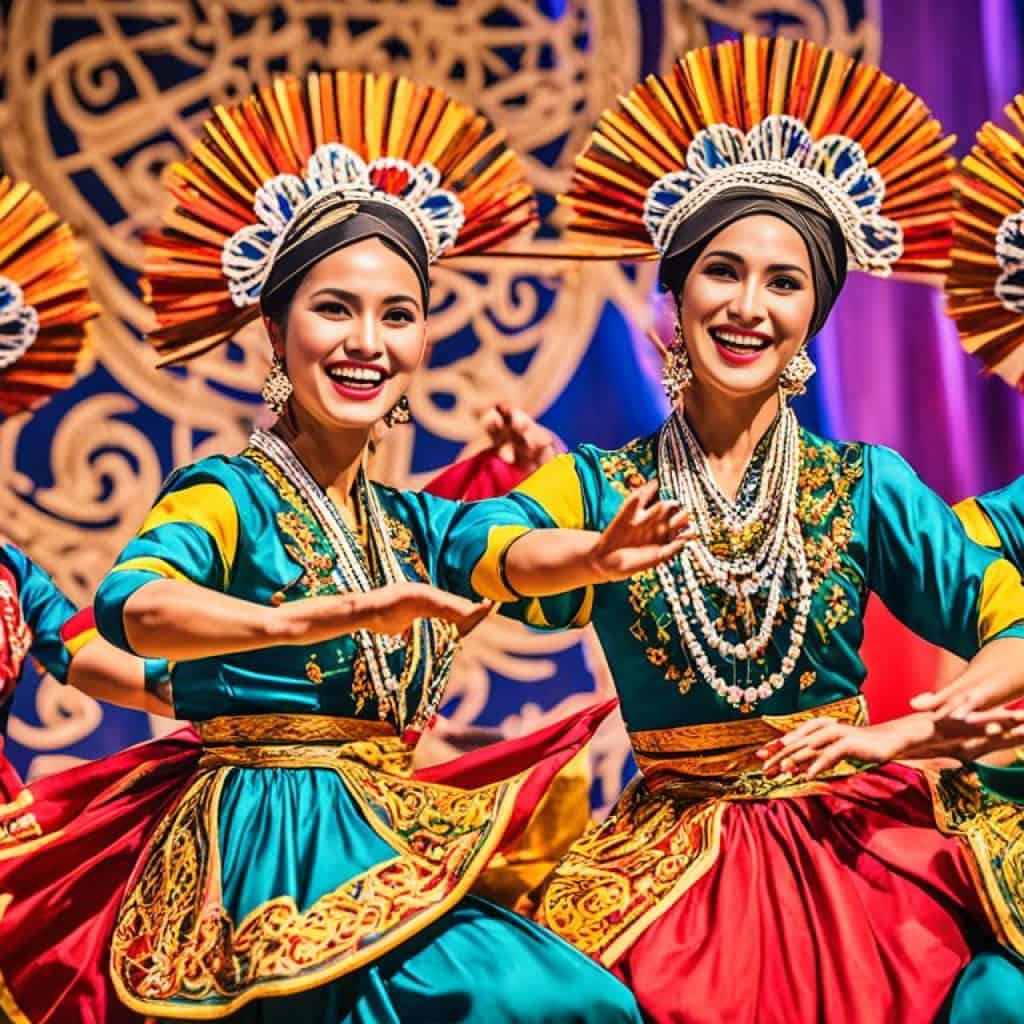
The Story of Singkil
The dance of Singkil is inspired by the epic legend of the “Darangen,” which narrates the struggles and triumphs of the Maranao people. The dance depicts the story of Princess Gandingan who is trapped in a forest during an earthquake caused by the wrath of the gods. Princess Gandingan elegantly navigates the bamboo poles, skillfully avoiding certain demise. With the assistance of her loyal companions and her precise movements, she emerges unscathed, representing the resilience and resourcefulness of the Maranao people in the face of adversity.
The dance of Singkil is characterized by its synchronization of movements with the rhythm of the kulintang, a set of gongs and drums. The dancers skillfully maneuver through the interwoven bamboo poles, representing the perils and challenges faced by the princess. The intricate footwork and graceful hand gestures reflect the elegance and grace of Princess Gandingan as she triumphantly navigates the obstacles in her path.
“Singkil is not just a dance; it is a testament to the rich cultural heritage and resilience of the Maranao people, passed down from generation to generation.” – Maranao Folklorist
The Cultural Significance of Singkil
Singkil holds immense cultural significance for the Maranao people and the Philippines as a whole. It is not only a showcase of ancient traditions and artistry but also a representation of the spirit and strength of the Maranao culture. Singkil is often performed during cultural festivals and celebrations, highlighting the deep-rooted traditions and values of the Maranao community.
Through Singkil, the Maranao people have preserved and shared their rich heritage with the world, serving as a source of cultural pride and identity. The dance embodies the resilience, elegance, and determination of the Princess Gandingan, reflecting the shared experiences and values of the Maranao people.
La Jota Moncadeña – A Spanish-Influenced Dance
La Jota Moncadeña is a captivating Spanish-influenced folk dance that originated from Moncada, Tarlac. This traditional dance combines the graceful movements of Spanish dance with unique Ilocano elements, creating a vibrant and culturally rich performance.
La Jota Moncadeña is characterized by its lively and energetic choreography, accompanied by the rhythmic sound of castanets and traditional Spanish music. Dancers elegantly glide and twirl across the dance floor, showcasing the influence of Spanish colonialism on Philippine culture.
This folk dance is often performed at special celebrations, festivals, and cultural events, where its lively beats and vibrant movements ignite a sense of joy and celebration. Through La Jota Moncadeña, dancers and spectators alike pay homage to the historical ties between the Philippines and Spain, preserving the rich heritage of both cultures.
With its combination of Spanish and Ilocano influences, La Jota Moncadeña stands as a testament to the diverse and multicultural nature of the Philippines. This dance reflects the creativity and adaptability of the Filipino people, as they seamlessly blend different cultural elements into a cohesive and captivating performance.
Experience the enchantment of La Jota Moncadeña as it transports you to a world where Spanish and Filipino traditions converge, creating a cultural harmony that is uniquely Philippine.
Conclusion
Philippine folk dances are a vibrant and captivating representation of the country’s diverse culture and heritage. These ethnic dances, deeply rooted in the traditions and values of different regions, paint a tapestry of creativity, resilience, and unity among the Filipino people. Preserving and promoting these unique dances is crucial in ensuring that future generations can fully appreciate and celebrate their rich cultural identity.
From the energetic and synchronized movements of Tinikling, symbolizing agility and grace, to the graceful elegance of Pandanggo sa Ilaw, celebrating the beauty of light, and the symbolic battles portrayed in Maglalatik, each ethnic dance tells a story steeped in tradition. These dances are a testament to the resilience and creativity of the Filipino people, carrying with them the echoes of generations past.
By immersing themselves in the vibrant world of Philippine folk dances, both performers and spectators alike can experience the cultural richness of the country. These dances unite communities, foster a sense of pride and identity, and serve as a living testament to the traditions that have shaped the Philippines over centuries. As the world evolves, preserving and honoring these ethnic dances is of utmost importance, allowing the Filipino culture to thrive and continue to inspire generations to come.
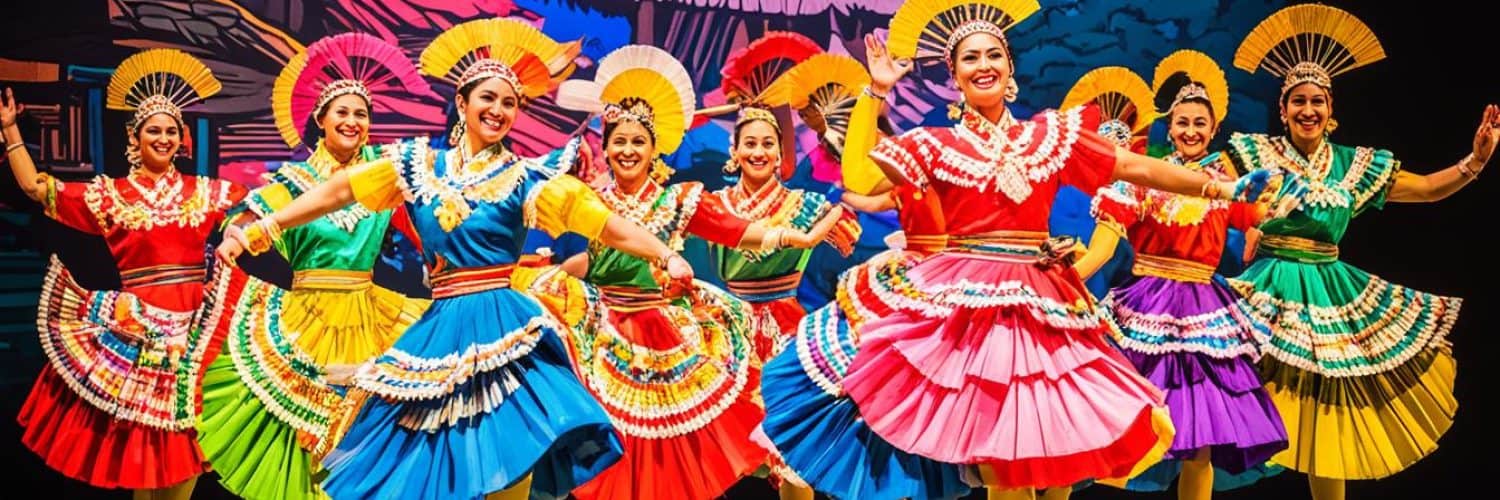
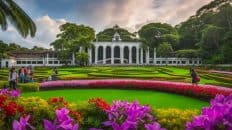












Add comment